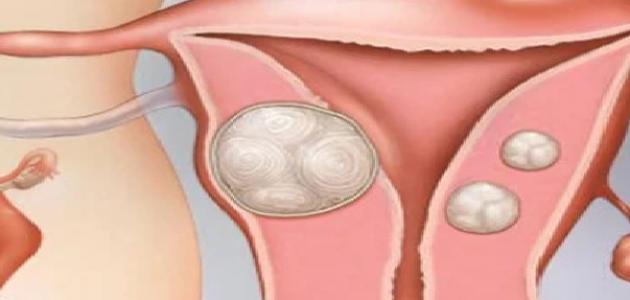Reasons for increasing menstrual cycle days
Although the number of days of the menstrual cycle exceeding seven days is considered heavy menstruation, it is worth noting the need to take into account the number of days of the woman’s menstrual cycle in a normal situation, meaning that if the number of days of the woman’s menstrual cycle is eight or nine days, from the beginning of Menstrual bleeding, this condition is not a cause for concern, but if the woman’s bleeding usually lasts for five days and then becomes eight or nine days; Then it is considered heavy menstruation and requires attention and a visit to the doctor.
In fact, the problem of longer than normal menstrual cycle days is a common gynecological problem, and the reasons behind its occurrence may be multiple. In some cases, it is attributed to hormonal disturbances, problems related to the uterus, or other things. The most common reasons are detailed as follows:
Ovulation does not occur
Ovulation means the ovaries release a mature egg once a month. In some cases, the menstrual cycle may occur without ovulation, meaning the mature egg is not released from the ovary, which causes menstrual irregularity. This condition is most commonly observed in women who Those who are approaching menopause and those who have recently started menstruating, that is, at the beginning of their adulthood. It is also worth knowing that any imbalance in the endocrine system may cause a disturbance in ovulation, affecting the course of the menstrual cycle and leading to its irregularity.
Read also:What are the causes of menstrual progression?In some cases, ovulation may occur at the end of the menstrual cycle, which may be accompanied by minor bleeding, which leads to the belief that the menstrual cycle has not stopped. Therefore, it can be classified as one of the reasons why the menstrual cycle does not stop or the number of days exceeds the normal rate.
Contraceptives
Many types of contraceptives can be mentioned in some detail as follows:
- IUD: Usually, the IUD causes cramps in addition to heavy menstruation. It is worth clarifying that both types of IUD (hormonal and non-hormonal) can cause heavy menstrual bleeding, knowing that this side effect is most noticeable if the IUD is used for the first time, and it is good. Heavy bleeding usually ends three to six months after its installation. As the woman's body gets used to it, and as for the reason behind its use; Sometimes it is used for contraceptive purposes, as it is implanted in the uterus.
- Pills: (in English: Birth control pills), although birth control pills are used to regulate the menstrual cycle or reduce the number of days, in some cases they may cause an increase in the number of days of the menstrual cycle or a heavy amount of menstruation in general, and this is due to the hormonal changes that they cause in the The body, its side effects (including menorrhagia) are most noticeable in the first few months of use. On the other hand, it is indicated that stopping taking birth control pills may cause an increase in the number of days of the menstrual cycle, because taking them often leads to Shortening the menstrual cycle. The use of these pills may also be one of the reasons for non-stop bleeding after menstruation or bleeding between menstrual cycles.
Many women may suffer from an increase in the number of days in their menstrual cycle after using contraceptives, and this increases significantly if the woman chooses an intrauterine device as a contraceptive. Contraceptives may also cause heavy menstrual periods in general, and the reason for this is due to the hormonal changes that they cause in the the body.
Read also:What are the causes of menstrual progression?
Hormonal imbalance
In a normal situation, there is a balance between the level of estrogen and progesterone, and this balance is responsible for regulating the process of building the lining of the uterine layer that is shed during menstruation, and in the event of a hormonal imbalance mentioned above; The uterine lining grows larger, causing heavy menstruation when it occurs, and treating this imbalance contributes to treating the increased days of the menstrual cycle.
In addition to the previously mentioned hormone imbalance; An imbalance in the level and balance of endocrine system hormones may cause menorrhagia, including an increase in the number of days in the menstrual cycle. Examples of these hormonal imbalances include the following:
- Disorders and problems of the adrenal glands.
- Hyperthyroidism and hypothyroidism. The good thing is that when these two problems are treated and the level of thyroid hormones is controlled, the menstrual cycle becomes regular again.
- Tumors of the pituitary gland that secrete the hormone prolactin: (in English: Prolactin-producing pituitary tumors), as these hormones cause an imbalance in the level of the hormone responsible for stimulating the secretion of some hormones associated with the menstrual cycle. More clearly, these tumors cause an imbalance in the level of the gonadotropin-releasing hormone, or gonadotropin-releasing hormone. Releasing gonadotropin-releasing hormone, and thus the levels of luteinizing hormone and follicle-stimulating hormone decrease, and episodes of menorrhagia may be observed when this occurs.
- Polycystic ovary syndrome: or polycystic ovary syndrome (in English: Polycystic ovary syndrome), or PCOS for short. Symptoms associated with this condition include: irregular menstrual cycle, absence of ovulation, obesity, hirsutism, and others.
- Hyperinsulinemia: This problem usually occurs as a result of obesity and weight gain, and is represented by an increased secretion of insulin by the body. This condition causes the ovaries to produce androgens, just as happens in cases of polycystic ovary syndrome, which leads to the appearance of symptoms associated with irregular menstrual cycle.
Women may suffer from an increase in the number of days in the menstrual cycle as a result of a change in the level and balance of hormones in the body. Both estrogen and progesterone are the main hormones responsible for regulating the menstrual cycle. If a woman suffers from some health disorders that affect the level of these hormones, she will suffer in this case from changes. In the menstrual cycle, including menorrhagia and an increase in the number of days in the menstrual cycle.
Read also:Accelerate the menstrual cycle
pharmaceutical
Some medications may cause an increase in the number of days in the menstrual cycle or heavy menstruation. Examples of these medications include: some anti-inflammatory drugs, hormones such as estrogen and progesterone, warfarin, and enoxaparin.
migratory endometrium
Endometriosis is also known as endometriosis, and is represented by the growth of endometrial tissue outside the uterus. The first main symptom of this problem is a disturbance or irregularity in the menstrual cycle, including menorrhagia, in addition to menstrual pain that does not respond to anti-inflammatory drugs. Non-steroidal anti-inflammatory drugs, such as ibuprofen.
The effect of endometriosis can be linked to the number of days of the menstrual cycle, as increasing the thickness of the lining necessarily causes an increase in the number of days of the menstrual cycle until the lining is completely shed, which is one of the reasons for menstruation every 10 days or more than once in a month.
miscarriage
A miscarriage usually causes spotting or severe bleeding, and this bleeding can last from a few hours to several weeks. A miscarriage may occur even before the woman realizes that she is pregnant. In any case, it is necessary to consult a doctor in cases of miscarriage to ensure that no complications develop.
pregnancy
One of the symptoms that may appear in some women and are associated with pregnancy is spotting or minor bleeding. This may be related to other symptoms of pregnancy, such as nausea, or it may not be related to any symptom. On the other hand, severe bleeding that occurs during pregnancy is linked to the possibility of the fetus forming outside the uterus, and this condition is known as pregnancy. Ectopic pregnancy, and such a condition requires immediate medical care to avoid serious complications.
It is worth noting that as soon as pregnancy occurs, you must consult a doctor to confirm whether the pregnancy is normal and in its correct location or outside the uterus. The doctor will order a blood test and perform an ultrasound scan, and women are generally recommended to perform a home pregnancy test if pregnancy is suspected.
Adenomyosis
The term adenomyosis refers to a condition in which the lining of the uterus becomes part of its wall, and this condition may cause pain associated with the menstrual cycle.
Uterine polyps
Uterine polyps are defined as benign growths that appear in the uterus or in its neck. Their size is usually the size of a pencil eraser, and sometimes their size may reach the size of an orange. Because of their small size, they usually do not cause any significant symptoms, but If it causes symptoms, they include heavy menstruation, bleeding after intercourse, or bleeding between one menstrual cycle and another.
uterine fibers
Uterine fibroids are known as growths that appear in or around the uterus and cause dysmenorrhea or severe pain accompanying or heavy menstruation. They are most noticeable in women between the ages of 35-50 years, and may cause bleeding during menstruation. Menopause (menopause) and bleeding may appear in the form of lumps.
pelvic inflammatory disease
Pelvic Inflammatory Disease is an infection that occurs in the upper part of the female reproductive organs, which includes the ovaries, uterus, and fallopian tubes. Symptoms of this condition include: high temperature, vaginal discharge, and bleeding after intercourse or Between one menstrual cycle and the next, as well as abdominal and pelvic pain.
bleeding disorders
The ability of blood to clot plays an important role in regulating menstrual bleeding. Therefore, blood disorders that are associated with clotting and bleeding may cause heavy menstrual bleeding, including an increase in the number of days in the menstrual cycle. Some of these conditions are genetic and some are acquired during the woman’s life. , Such as:
- Von Willebrand disease: (in English: Von Willebrand disease), which is one of the most common hereditary blood diseases and causes a delay in bleeding in the body.
- Thrombocytopenia: Thrombocytopenia is a condition represented by a low number of platelets, knowing that platelets are small cells found in the blood and their importance lies in the formation of the initial blood clot in the event of bleeding in the body and thus reducing bleeding. Accordingly, thrombocytopenia or the occurrence of Any other platelet-related disorder may cause heavy menstrual bleeding.
Other health conditions
Other health conditions that may cause an increase in the number of days in the menstrual cycle include:
- Uterine cancer: In fact, there are no clear symptoms specific to uterine cancer. Some symptoms may be related to other health problems, and in other cases cancer may occur without causing these symptoms, including:
- Abnormal vaginal blood spotting.
- Abnormal vaginal discharge.
- Abnormal vaginal bleeding.
- Menorrhagia, including an increase in the number of days of the menstrual cycle in women who are approaching menopause.
- Pain in the pelvic area.
- Liver problems.
- Kidney disorders.
When should you see a doctor?
You should consult a doctor in the following cases:
- Severe vaginal bleeding leads to changing the sanitary pad every hour or two hours at most.
- Vaginal bleeding after menopause.
- Vaginal bleeding between menstrual periods.
- Irregular vaginal bleeding.
How to act if the number of menstrual days increases
There are some tips that help reduce the number of days in the menstrual cycle, including the following:
- Drink enough water.
- Make sure to eat healthy foods such as vegetables and fruits.
- Apply warm water compresses to the abdomen.
- Take a warm water bath.
- Massage the uterine area.
- Avoid using tampons and replace them with sanitary pads.
Preventing anemia and deficiency of minerals and vitamins
Women who suffer from anemia and deficiency of minerals and vitamins resulting from menorrhagia should consult a doctor so that he can prescribe appropriate nutritional supplements that contain iron, folic acid, vitamin B12, etc., in addition to the need to commit to eating foods rich in these elements and vitamins to avoid the resulting deficiency. Among these foods are the following:
- Liver and red meat.
- Green leafy vegetables such as spinach and arugula.
- Whole grains or fortified breakfast cereals.
- brown rice;
- eggs.
- fish.
- chicken.
- Tofu.
- Dried fruits; Such as dried apricots, peaches and raisins.
Article summary
There are many reasons for the number of days in the menstrual cycle to increase beyond the normal rate, which may be natural in some cases, such as young age, approaching menopause, or in the first stage of using some contraceptive methods such as birth control pills, or the increase may be due to reasons other than that. Natural or pathological, such as endometriosis, uterine fibroids, and other disorders, which requires seeing a doctor in the event of suffering from a disorder in the menstrual cycle for several months without a clear cause for the disorder, for early detection of health problems and undergoing appropriate treatment according to the condition and need.









